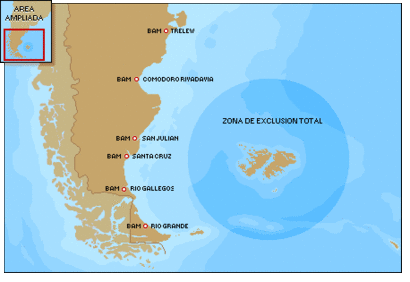Total Exclusion Zone facts for kids
The Total Exclusion Zone (TEZ) was a special area created by the United Kingdom on April 30, 1982. It was a circle stretching about 370 kilometers (200 nautical miles) around the center of the Falkland Islands. During the Falklands War, any ship or aircraft from any country that entered this zone could have been attacked without a warning.
Contents
What Was the Exclusion Zone?
Before the Total Exclusion Zone, a similar area called the Maritime Exclusion Zone (MEZ) was set up on April 12, 1982. This zone also covered a circle about 370 kilometers (200 nautical miles) around the Falkland Islands. In this first zone, only Argentine warships or support ships could be attacked by British nuclear submarines.
Warning from the UK
On April 23, the British government sent a clear message to Argentina. They said that any Argentine ship or aircraft that seemed to be a danger to British forces anywhere in the South Atlantic would be attacked. This warning was very important.
The message explained that even though they had set up the Maritime Exclusion Zone, the UK still had the right to protect itself. This right is allowed under Article 51 of the United Nations Charter. They made it clear that any Argentine warships, submarines, support ships, or military aircraft that looked like a threat would be met with a strong response. Even civilian planes, if they were watching British forces, would be seen as a danger.
Why Civilian Planes Were Mentioned
The mention of "civilian aircraft" was mostly about a Boeing 707 plane from the Argentine Air Force. This plane had been flying near the British ships as they traveled south. British Sea Harrier jets had to escort it away many times.
The Total Exclusion Zone Begins
The Total Exclusion Zone (TEZ) was announced by the United Kingdom on April 30, 1982. It covered the same area as the earlier Maritime Exclusion Zone. The big difference was that in the TEZ, any ship or aircraft from any country that entered the zone could be attacked without warning.
Some people have called this zone "legally questionable." This is because it went beyond the usual rules for Maritime Exclusion Zones in international law. Those rules usually protect ships and planes from countries not involved in the war.
The Sinking of the ARA General Belgrano
One very famous event was when the Argentine ship ARA General Belgrano was sunk on May 2, 1982. This happened outside the Total Exclusion Zone. This led to a lot of discussion and disagreement about whether the attack was fair or legal.
However, exclusion zones are usually set up to help neutral ships stay safe. During a war, under international law, where a fighting ship is located doesn't change its status. It's still a military target. The captain of the Belgrano, Héctor Bonzo, even said that the attack was legitimate. The Argentine government also agreed with this in 1994.
What Argentine Officers Understood
Interviews for a book called The Fight for the "Malvinas" showed that Argentine Navy officers understood the British warning. They knew that any ships operating near the exclusion zone could be attacked. Argentine Rear-Admiral Allara, who was in charge of the group of ships that included the Belgrano, said, "After that message of 23 April, the entire South Atlantic was an operational theatre for both sides. We, as professionals, said it was just too bad that we lost the Belgrano." This means they understood the danger.
Extending the Zone
On May 7, 1982, the Total Exclusion Zone was made even bigger. It was extended to be as close as 22 kilometers (12 nautical miles) from the coast of Argentina.


